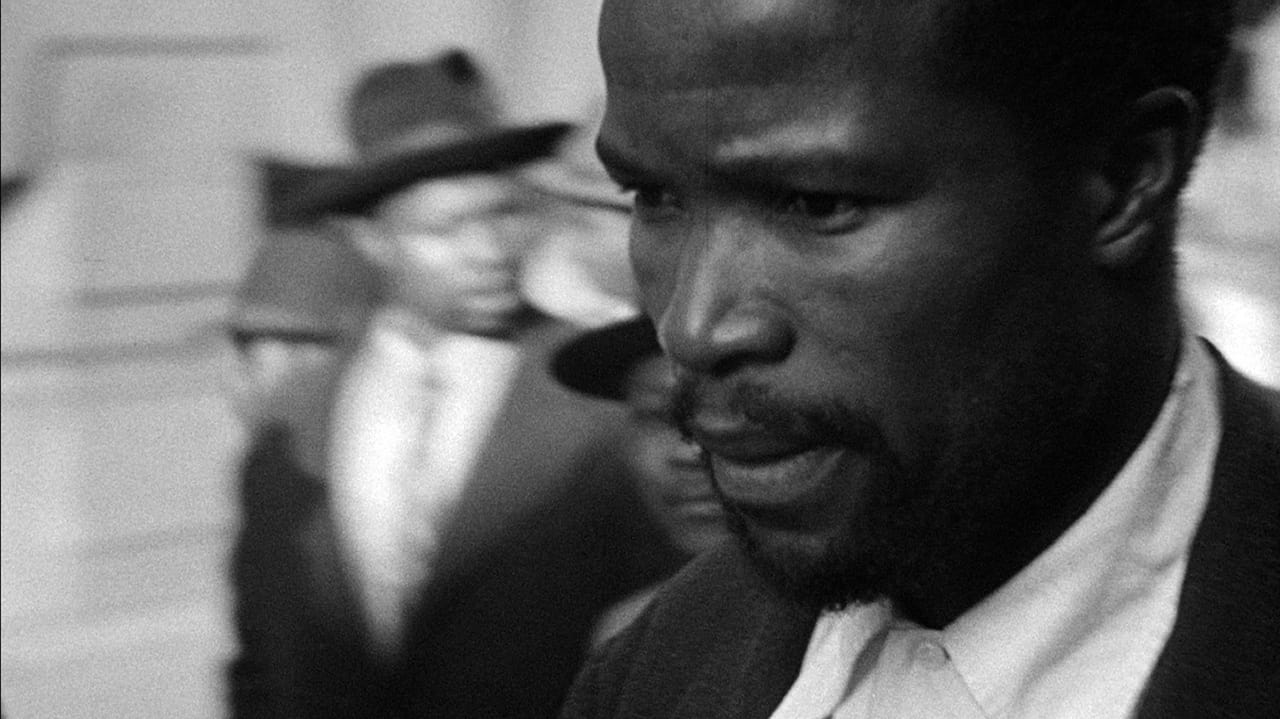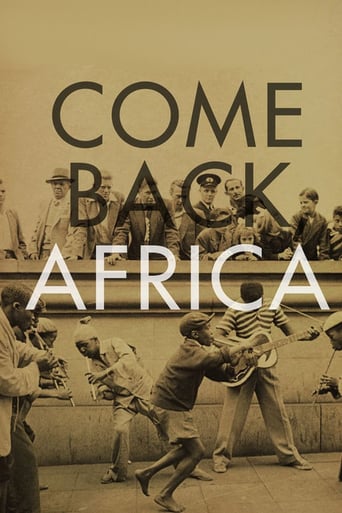

I wanted to but couldn't!
... View MoreAlthough it has its amusing moments, in eneral the plot does not convince.
... View MoreI was totally surprised at how great this film.You could feel your paranoia rise as the film went on and as you gradually learned the details of the real situation.
... View MoreIt’s fine. It's literally the definition of a fine movie. You’ve seen it before, you know every beat and outcome before the characters even do. Only question is how much escapism you’re looking for.
... View MoreThe vividness of the images in COME BACK Africa give it a thematic gravity that few films can approach or claim. Anyone who has ever worked in the factory will understand Zacharia's sojourn into the mines.The sights of the principal actors moving and living in squalid conditions are so strong you can almost smell the reek of the environs. Zacharia works hard, but the atmosphere of poverty that pervades this story proves to have a stifling effect on everything he is and does and seeks to attain. The draconian measures of Apartheid make it almost impossible to kindle any real hope for upward mobility. Zacharia is allowed only enough freedom to work in the mines and return home. He casts about for a scent of viable opportunities, but the racist climate of South Africa seems to nullify even the consideration of capitalizing on advantages that might come to a person of color. Zacharia works at several jobs, but always seems to somehow violate some kind of social convention that ranks him back among the outcasts.There is a scene where he meets with his peers to discuss informally what kind of options exist to make things better in their lives. There is an improvised feeling about this discussion and it is here where the cinema verite' technique flickers and shines intermittently to reveal flashes of urban character. When Miriam Makeba makes her entrance upon the scene, her sense of inner richness lightens to some degree the mood of futility that hovers over the conversation between friends. I have read this film of ethnofiction was a contributing factor to her escaping South Africa with the help of filmmaker Lionel Rogosin to begin her singing career in America and around the world.Zacharia attempts to create some semblance of family life by bringing his wife to Sophiatown. Vinah suggests to Zacharia that she too find employment, but this proves to be problematic as well, and in the end simply hastens them downward into a spiral of tragedy. Under the umbrella of poverty we watch the characters sing and dance and sigh in protest to the suffocating conditions of apartheid racism.While the ending is abrupt and simply repeats that old familiar refrain of white privilege making up the rules that sponsors and patronizes the impoverishment of the indigenous communities it displaces, this neo-realistic approach gives the subject a fresh and compelling point of view. Since many of the actors are actually playing versions of themselves living a life that they intimately know, the film has an authority that is rooted in reality more than the opinion or the imagination of any particular individual. This gives one the feeling that what the participants are living and feeling and thinking and saying is the real deal and is not a substitute for the truth.
... View More"Come back Africa" is a 1959 black and white film that is part documentary and part fiction. The documentary sections provide a compelling look at life in a Johannesburg township in 1959 and life for blacks and Afrikaners in the City itself. Interwoven with this documentary is a fictional account of the life of a rural Black man who comes to Johannesburg looking for work. All the performers are real people and not actors, which is more than evident, and the scenes take place in real locations.The singer Miriam Makeba (1932-2008) is featured in the film, and as a result of her performance she managed to escape South Africa and came to the U.S. where she began a distinguished career. Producer Lionel Rogosin (1924-2000) helped her escape, supported her, and established the Bleecker Street Cinema in 1960 where "Come Back Africa" and other "art" shows had a chance to be displayed, influencing the careers of many future film makers.I lived in South Africa from 1977 to 1980 and can attest to many of the scenes you will see, which take place in 1959 but which were still present when I was there. By the time I lived there life was less pleasant for many than it was at the time of this filming, if you can imagine that.This is a unique film and one that can be watched mostly for its historical importance, and as a representation of a genre that is under represented.There are many films about life in South Africa. Among the best are "Shaka Zulu" (1986) and "Zulu" (1964) for the colonial days, "Cry the Beloved Country" (1951) and "A Dry White Season" (1989) for the in between years, "Inside" (1996) and "Mandela and de Klerk" (1997) for the more recent vista.
... View MoreLionel Rogosin in co-operation with the staff of the iconic Drum magazine of the 1950's create an accurate and unbiased portrayal of township life in South Africa under apartheid. Written by Lewis Nkosi and Bloke Modisane and starring a collection of South Africa's brightest black urban stars of the fifties, this film broke new ground in the manner in which it showcased African urban identity and the hardships and realities of township life in the magical place known as Sophiatown. Rogosin had entered South Africa and shot this film under false pretences while constantly being hounded by strict apartheid legislature. Sophiatown was destroyed by the apartheid government in 1957 and replaced by the white suburb triomf (triump). This film is one of the few documents left that survive a township where black, white, Indian and coloured residents lived together decades before the 'rainbow nation' ideology of modern day South Africa.
... View MoreThis film on apartheid in South Africa established Lionel Rogosin as master of cinema verite. The use of actual settings and non-professional actors in telling a story set a tone of reality far beyond any movies of the time. The images are still haunting five decades later.
... View More